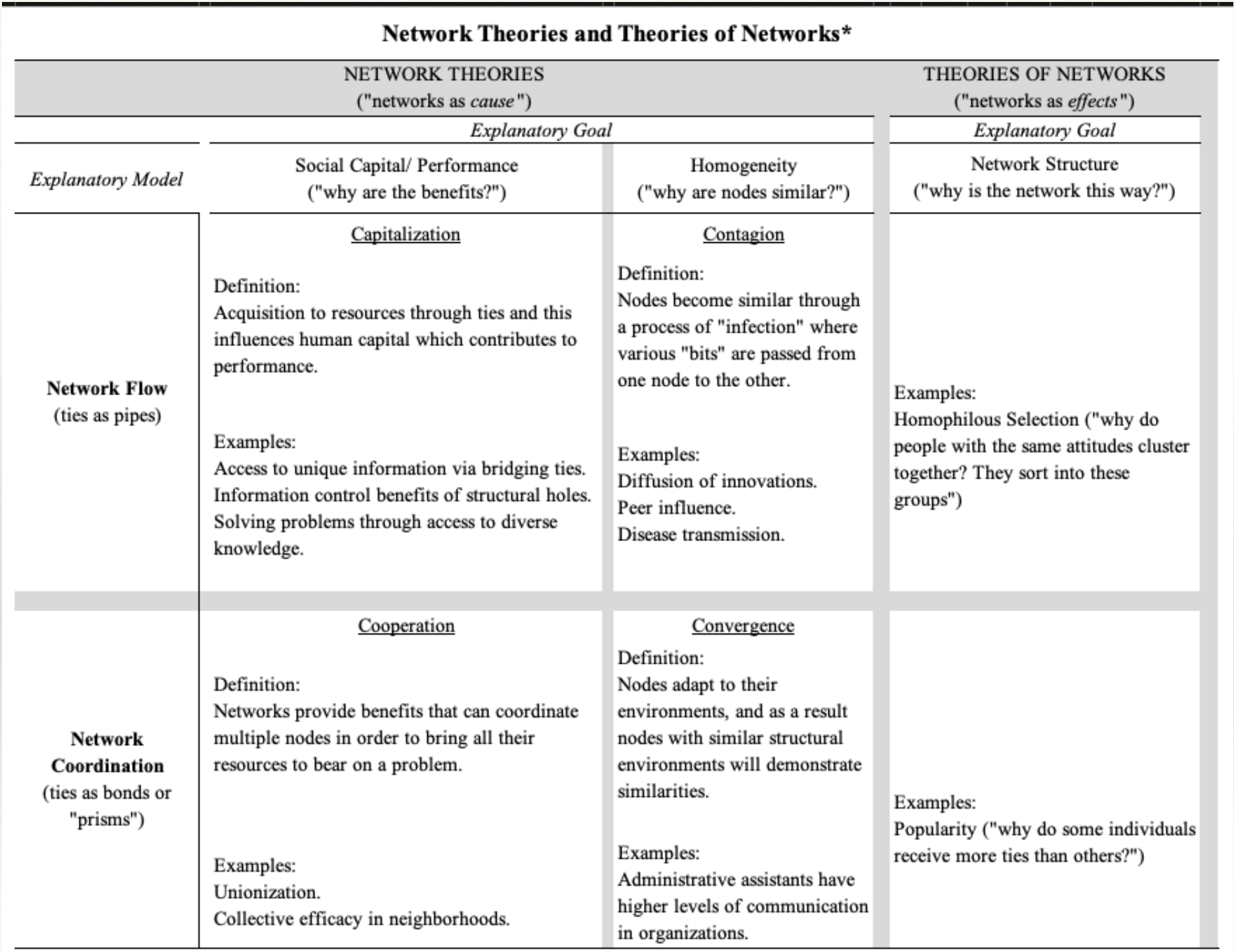Chapter 2: Social Network Analysis and Theory
Learning Goals
- Understand the theoretical basis of network science
Organizing Knowledge
As discussed in Chapter 1: Introduction to Social Network Analysis, network science takes relational structures as the primary domain of interest. In so doing, research questions take the following forms:
- How does the network matter?
- Here the network is an independent variable. In the case above, the network of shared incidents was as independent variable that influenced views of body-worn cameras.
- What effects the network?
- Here, the network is a dependent variable. Do younger individuals who are involved in crime have more co-offenders?
Building from this, we can think about organizing social network analyses around the following general classification of ideas:
- Network Theories (networks as “cause”)
- Theories of Networks (networks as “effect”)
We can classify studies based on the Explanatory Model (what is the metaphor for the network?) and the Explanatory Goal (what are we trying to explain?).
The Explanatory model differentiates between two different metaphors for what networks do: flow (where “stuff” flows through ties like a pipe) and coordination (ties are like bonds in that they coordinate action)
The Explanatory goal differentiates between what we are trying to understand: social capital/performance (what are the benefits of a position? How does it render advantage?), homogeneity (why are nodes similar?), and network structure (why is the network like this?).
These dimensions give as a 2x3 table where by which we can better classify studies:

Mechanisms in Network Theory
Capitalization
Model: Flow
Goal: Social Capital/Performance
This mechanism explains the benefits of social ties as providing resources. That is, individuals are able to capitalize on their ties and this produces variation in resources.
As an example, consider the following question: why do some people stay out of prison when they return to the community?
Several studies point to the importance of social support upon reentry. Individuals who are able to draw on a diverse set of resources in their social network are better able to navigate life on the outside.
Contagion
Model: Flow
Goal: Homogeneity
This mechanism explains homogeneity among nodes as the result of an “infection” process. That is, individuals are similar because of their exposure in their social network.
As an example, think about this question: why are people victims of gun violence?
A study suggests that exposure to particular behavioral settings increases the risk of gun violence. Specifically, being around those who have been the victim of gun violence. These situations think of victimization in epidemiological terms.
Cooperation
Model: Coordination
Goal: Social Capital/Performance
Ties facilitate coordination to solve some problem. For example, why can some groups enforce norms? According to Coleman (1990), network closure strengthens idetity and distributes sanctioning costs allowing groups with this property to enforce norms.
Convergence
Model: Coordination
Goal: Homogeneity
Nodes respond to or adapt to their environment. Homogeneity is a consequence of this structural similarity. For example, who is most likely to engage in relational violence? Some work suggests that adolescents in the middle of the friendship hierarchy (not the top or bottom) tend to engage in relational violence to maintain position and move through the hierarchy.
Theories of Networks
Usually adopt one of the metaphors (i.e. network flow or network coordination) to address the question, “why is the network this way?”
Summary
The table below summarizes the major approaches to organizing social network analyses:

Continue to Chapter 3: Social Network Analysis and Methods for Data Collection
Please report any corrections or comments to the Issues page. Thanks!